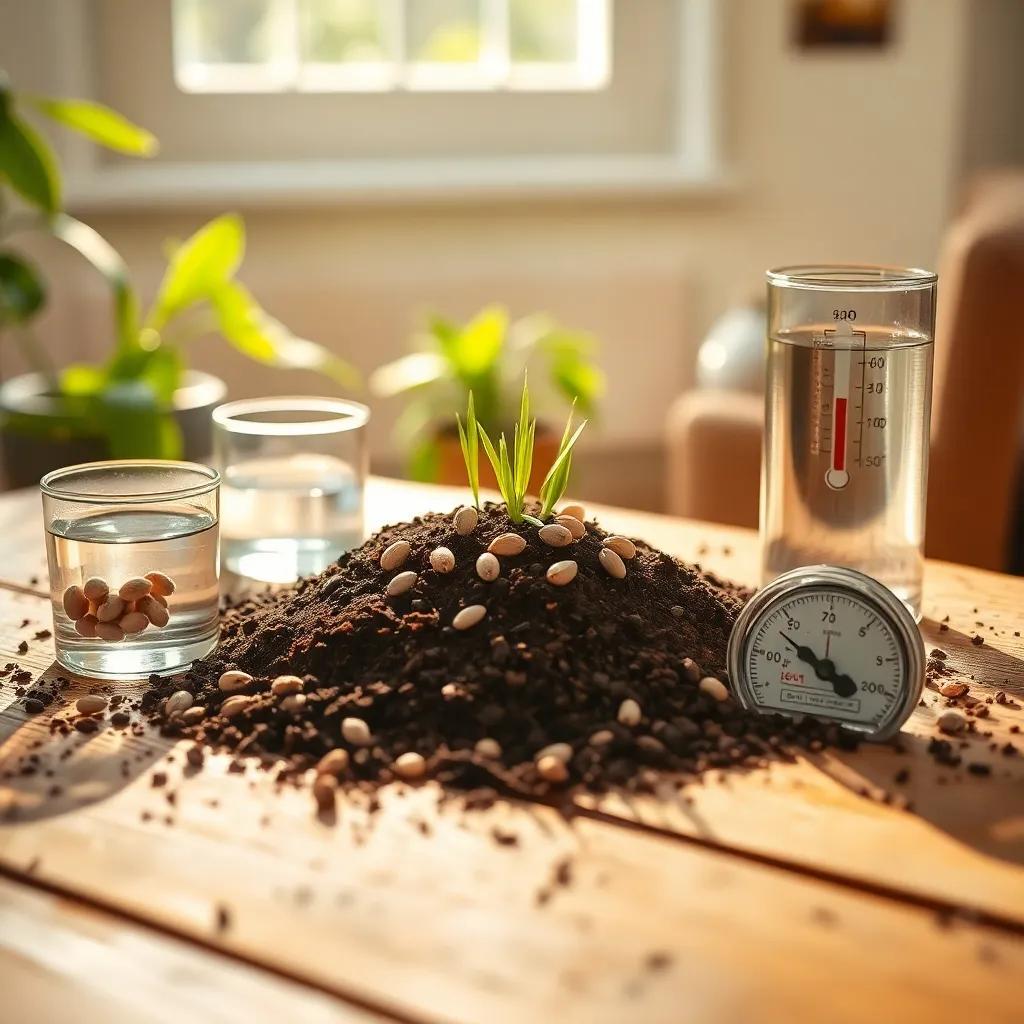Have you ever marveled at the graceful plumes of pampas grass swaying in the breeze? Growing these stunning plants from seeds can be an exciting adventure, and I’m here to share the secrets of making it a success! Let’s dive into the world of pampas grass germination and discover how to nurture these beauties into your garden.
understanding the Germination Process of Pampas Grass
Germination is like the magical moment when a tiny seed wakes up and starts its journey to becoming a beautiful plant! When it comes to pampas grass, this process can be both interesting and a bit tricky. So, what actually happens during germination? Let me break it down for you!
First, when you plant those little pampas grass seeds, they have a protective outer shell called a seed coat. This coat is tough and keeps the seed safe until the right conditions come along—think of it as a cozy blanket! To start germinating, the seed needs three things: water, warmth, and light.
- Water: The first step is for the seed to absorb water. When it drinks up enough water, the seed coat softens. This is when the magic starts! The seed starts to swell,and that’s a good sign you’re on the right track.
- Temperature: Next up is temperature. Pampas grass seeds prefer a cozy atmosphere, typically between 65°F and 75°F (that’s about 18°C to 24°C). Too cold, and the seeds might just stay tucked in; too hot, and they coudl get hurt.
- light: these seeds love light! Unlike some plants, they don’t need to be buried deep in the soil. Just a light sprinkle of soil on top will do—this lets the sunshine peek thru and gives the seeds the boost they need!
once all these conditions are met, the germination process kick-starts. The seed starts to sprout, sending down tiny roots called radicles and pushing up what we call the epicotyl. This little shoot is on its way to becoming a lovely pampas grass plant, ready to grow tall and proud!
Key Factors influencing Germination Time
Now that we’ve covered the basics of germination, let’s dig into the factors that can affect how long it takes for pampas grass seeds to sprout. Understanding these can definitely help us create the best surroundings for our future garden stars!
- Water: Just like humans, seeds need water to thrive! Too little moisture, and the seeds won’t activate. Too much, and they might rot. It’s a balancing act—keeping the soil damp but not soggy is key.
- Temperature: As mentioned before, the right temperature is vital. If your seeds are too chilly,they might decide to take a long nap. Aim for that comfy 65°F to 75°F range to give them the best chance.
- Light: Pampas grass seeds want to soak up light. If they’re buried too deep, they won’t get what they need. Make sure they are just lightly covered to make germination easier.
- Soil Quality: The soil matters too! Pampas grass loves well-draining soil full of nutrients. If the soil is too heavy or compacted, it might slow down the germination process.
- Seed Quality: Lastly, make sure to use fresh seeds! Old or low-quality seeds might not germinate properly, so investing in good seeds can really pay off.
Being aware of these factors can help us create the perfect setting for our pampas grass seeds, turning that initial excitement into a thriving garden. So, let’s get ready to give our seeds the loving care they need!

Ideal Conditions for Accomplished Pampas Grass Germination
Creating the ideal conditions for germinating pampas grass seeds is like setting the stage for a breathtaking performance. If you want your seeds to thrive and grow into those stunning, feathery plants we adore, you need to think about a few key elements!
- Sunlight: Pampas grass loves sunlight! Aim for at least six hours of direct sunlight each day. If the sun can shine brightly on your seeds, they’ll be much happier and healthier. Find a sunny spot in your garden that gets plenty of light.
- Soil Quality: The soil is the foundation of your plants. Pampas grass prefers well-draining soil that’s rich in organic matter. You can mix some compost or well-rotted manure into the soil before planting. This will provide those nutrients to help your seeds grow strong.
- Watering: During germination, it’s significant to keep the soil consistently moist, but not waterlogged. Too much water can drown the seeds, while not enough can dry them out. A good rule of thumb is to water your seeds lightly every day until they sprout. Once they’re growing, you can cut back to once or twice a week.
- Temperature: Remember that temperature matters! Try to keep your seeds in that lovely range of 65°F to 75°F.If you live in an area where temperatures fluctuate a lot, consider starting your seeds indoors, where you can control the climate better.
- Spacing: Once your seedlings pop up, don’t forget to give them space! Pampas grass can grow quite large, so plant them at least 4 to 6 feet apart.This gives them room to spread out and flourish.
With these conditions in mind, you’re well on your way to growing some fantastic pampas grass!
Tips for Maximizing Germination Success
Germinating pampas grass seeds can sometimes feel like a race against time, but with the right tips, you can boost your success! Here’s how to give your seeds the very best shot:
- Fresh Seeds are Best: Always start with fresh, high-quality seeds. Check the packaging for the harvest date. The fresher,the better!
- Scarification: A little trick I love is to scarify the seeds before soaking them. This means lightly scratching the surface of the seed coat.You can use fine sandpaper or a small file. It helps the seeds absorb water more easily.
- Pre-Soaking: After scarifying, soak the seeds in room temperature water for about 24 hours. This jumpstarts the germination process and allows the seeds to drink up some hydration.
- Monitor Temperature: Keep an eye on the temperature. If it’s too chilly, consider using a heating mat for extra warmth. However, be cautious not to overheat the seeds, as that can cause damage!
- Thin Out Seedlings: When multiple seedlings emerge in one spot, thin them out by snipping the weaker ones at soil level. This ensures the stronger plants have the resources they need to grow.
- Hardening Off: Before transplanting your seedlings outdoors,introduce them to the outside gradually. This process is called “hardening off.” Start with just a couple of hours in a sheltered place, then gradually increase their exposure to sun and wind over the course of a week or two.
By following these kind tips, you’ll be on your way to successful pampas grass germination, ready to create a beautiful garden oasis!
Common Challenges in Growing Pampas Grass Seeds
While growing pampas grass can be incredibly rewarding, there are a few challenges that can pop up along the way. Don’t worry! With a little extra care and attention, you can tackle these hurdles head-on.
- Low Germination Rate: Sometimes, not all seeds sprout, and that can be frustrating. Using fresh seeds and applying methods like scarification and soaking can help boost germination. also, provide the right conditions we talked about earlier!
- Slow Germination: If your seeds seem to take forever to sprout, remember that patience is key. Germination can take anywhere from 2 to 6 weeks. Keep the moisture and temperature just right, and don’t get discouraged!
- Damping Off: This is a fungal disease that can affect seedlings, causing them to collapse and die. To prevent this, use sterilized soil and containers. Make sure to provide good air circulation, and avoid overwatering. If damping off occurs, remove affected seedlings instantly.
- Pest Problems: Watch out for pests like aphids and slugs. They can wreak havoc on your young plants. Keep an eye out and use natural pest control methods, like introducing beneficial insects or using safe sprays if necessary.
- Weed Competition: Weeds love to invade! Keep the area around your seedlings clear of weeds.This makes sure that your pampas grass has all the nutrients, water, and light it needs to grow.
- Transplant Shock: When moving seedlings from indoors to outdoors, they might experience transplant shock, which can cause them to wilt. To help, harden them off gradually. Introduce them to outdoor conditions slowly to ease the transition.
By being aware of these challenges, you can navigate the ups and downs of growing pampas grass, and soon enough, you’ll have a garden filled with the graceful beauty of this fantastic plant!

